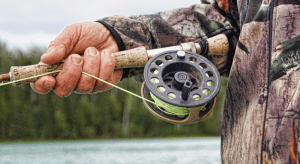
The “Grand Slam:” it’s a term whispered in reverent tones among new and old fishers alike. Tell your buddies you got the Canadian Grand Slam, and you’ve proven yourself to be a cut above the rest.
An angler who’s achieved a Grand Slam is recognized as one who has caught a collection of different game fish species in a single day. The International Game Fish Association (IGFA) shares that catching four species of fish in a day equals a Grand Slam.
The fact is, there a few places around the world that are famous for their opportunities to bag a Grand Slam. Florida, Australia, Mexico, and even Cuba boast their own particular benefits for bagging the challenge. Some of them are talked about among anglers the world over. Unfortunately, because of their popularity, there’s also a lot of competition for bites.
But there’s one Grand Slam that’s talked about in a unique way, and with a special sort of awe: the Canadian Grand Slam.Chasing this list provides the opportunity to catch some of the world’s best trophy fish. It requires stamina and experience. And, it brings hopeful anglers to some of the most beautiful, remote country in the world.
The Canadian Grand Slam challenges ambitious anglers to catch northern pike, lake trout, walleye, and Arctic graylingall in a single trip. And, while it’s not officially recognized by the IGFA, the respect it’s given by anglers the world over affords it a very special place on every fisher’s bucket list.
Fortunately, lodges like Big Sand Lake Lodge in Manitoba, Canada, have the guides, the know-how, and the world-class lodging you’ll need to make a go of this challenge (and its bragging rights). Here are some details on the trophy fish you’ll be pursuing as part of the Canadian Grand Slam.
Step 1: Catch a Northern Pike
This aggressive, toothy fish can typically be found in fresh (and sometimes brackish) water in the Northern Hemisphere. If you live in a North American region with a predictable ice cover, chances are good you have a stock of northern pikenearby. This fish is slimy and packs a bite—be careful, it bites line and fingers alike.
To catch a northern, the pros pack something heavier than a regular monofilament and bring pliers to fight those jaws. For lures, try in-line spinners, spoons, minnow-imitating plugs, spinnerbait, jig-and-worms, and surface plugs. As for timing, May is one of the best months to target pike in the US and Canada.
Step 2: Snag a Lake Trout
Lake trout—sometimes known as “mackinaw,” “lake char,” “tongue,” or “grey trout”—are valued as much for sport fishing as they are for food. Found primarily in the northern parts of North America, they are the largest of the char (according to the IGFA, the largest ever caught on rod and reel was a 59-inch 72-pounder [33 kg] in 1995).
Lake trout tend to hang around in shallow areas once the winter ice starts breaking up, so cast in the deeps and reel towards the shallows. For gear, we recommend a 9- or 10-weight fly rod with an intermediate sinking line. On spinning gear, try for 5- to 7-inch spoons or diving plugs, which mimic smaller trout.
Step 3: Lure in a Walleye
Also known as “yellow pike” or “yellow walleye,” walleyeare common to Canada and the Northern US. They have a reputation for being “short strikers,” hitting the bait without getting hooked. According to some experts, this could be due to fishermen not allowing the walleye’s inhalation-based feeding method to finish.
For the best success, try using a light, thin diameter line to decrease drag, and add a plastic body to a jig to increase the surface area when the fish starts sucking. Then, bounce the bait and shorten your stroke to snag ‘em in no time.
Step 4: Top it off with an Arctic Grayling
The Arctic Graylingis found throughout Canada, Alaska, and Siberia, as well as some parts of Montana. Arctic graylings have heavy appetites during their short summer growing season and they consume a lot of insects, crustaceans, fish eggs, and, at larger sizes, smaller fish.
They are relatively easy to handle (the world record is just over 5 pounds). An ultralight to light action spinning rod or 3- to 5-weight fly rod with monofilament line is recommended. Try small spoons and spinners on spinning tackle—they have small mouths.
Step 5: Have the Right Fishing Crew
Simply said, a guide can make or break your fishing trip. Every year, guests at Big Sand Lake Lodge routinely catch and release 20–30+ pound northern pike; 50+ pound lake trout; 3-4 pound (average) walleye; and trophy-sized Arctic grayling. The success and reputation of Big Sand Lake Lodge as Canada’s number one fly-in fishing destination has been built on the professionalism, experience, and big fish results their guides have provided guests. The proof is in the pictures – check out our collection of trophy fishfrom over the years.
Remotely situated within the subarctic wilderness of Canada, Big Sand Lake Lodge is located 525 miles north of Winnipeg, Manitoba. The only way to get there is to fly. The lake offers fishing diversity at its best, and its waters are exclusive to Big Sand Lake Lodge guests only. The main lodge is the only one on the lake—there are no communities and no cabins.
With fishing trips including transportation, meals, lodging, guides—and of course, fishing—a stay at Big Sand Lake Lodge is sure to satisfy your Canadian trophy fish Grand Slam dreams. The best news, those who catch the Canadian Grand Slam with us receive a $500 credit toward your next trip.
Thinking of pursuing your own Canadian Grand Slam? Book a trip to Big Sand Lake Lodge and discover how their world-class guides can help you find success.
